Effects of Diagonal Friction Dampers on Behavior of a Building
Abstract
1. Introduction
2. Experimental Studies
2.1. Design of Friction Dampers
2.2. Experimental Setup
2.3. Experimental Model Free Vibration Data
3. Numerical Studies
Earthquake Acceleration Records in Numerical Analysis
4. Results and Discussion
4.1. Hysteresis Responses of Friction Dampers
4.2. Comparison of Peak Roof Displacements
4.3. Comparison of Base and Floor Shear Forces
5. Conclusions and Recommendations
- In the 1-FD model, depending on the acceleration time histories of the earthquake records, the period value decreased by approximately 17% compared to the Reference building without a damper. This caused an increase of approximately 5% in the period value of the 5-FD building model. This evaluation shows that the dampers used on the lower floors affected the period properties of the building model more than the dampers used on the upper floors.
- In the case where the damper was placed on the ground floor of the building (1-FD), there was at least a 32% reduction in peak displacement compared to the Reference model without the damper. In the case where we used a damper on the second floor of the building, there was a decrease of at least 24% in the displacement, and at least 6% in the case where dampers were used on the the third and fourth floors. The damper being on the top floor caused an increase of at least 2%. The obtained results show that placing the dampers on the lower floors was more effective for peak displacement.
- The greatest reduction in roof displacement was obtained in the models where the dampers were placed close to the ground floors (1-2 FD and 1-3 FD). The reduction in displacement was lower in the 1-3-5 FD and Full-FD models than in these models. This result shows the importance of designing the dampers in sufficient quantity and with proper placement.
- The stiffness of the floor where the dampers were located was increased, thus causing an increase in the earthquake load acting on that floor. Therefore, the roof displacement increased. The increase in displacement in the model in which the friction damper was placed on the top floor of the building (5-FD) confirms this result.
- The reduction rates in roof displacement varied according to the earthquake record affecting the building. This result shows that the selection of the earthquake record in the design of friction dampers is important.
- The maximum reduction in shear forces in the building columns was 51% when dampers were used (1-FD) on the first floor of the building, while it was 7% when dampers were used on the fifth floor of the building. Placing the dampers on the lower floors was more effective in reducing the column shear forces.
- At the frequency corresponding to the building period, the variation in the floor shear force differed according to the spectral acceleration magnitude. Spectral acceleration shows that the damper had a smaller effect on the story shear force in large earthquakes and a greater effect in earthquakes with low spectral acceleration. Even if the ratio decreased, the effect of the damper in reducing the floor shear force was at least 50%. The dampers positively affected the floor where they were located the most, and the lower or upper floors.
Author Contributions
Funding
Institutional Review Board Statement
Informed Consent Statement
Data Availability Statement
Acknowledgments
Conflicts of Interest
References
- Bastami, M.; Jazany, R.A. Development of Eccentrically Interconnected Braced Frame (EIC-BF) for seismic regions. Thin-Walled Struct. 2018, 131, 451–463. [Google Scholar] [CrossRef]
- Bastami, M.; Jazany, R.A.; Mohamadi, A. Study of the seismic performance of Centrically Fused Braced Frame (CFBF). Thin-Walled Struct. 2019, 145, 106401. [Google Scholar] [CrossRef]
- Bastami, M.; Jazany, R.A. Development of centrically fused braced frame (CFBF) for seismic regions. Soil Dyn. Earthq. Eng. 2019, 127, 105856. [Google Scholar] [CrossRef]
- Wang, Y.; Zhou, Z.; Zhang, L.; Xie, Q. Quantification of higher mode effects of steel frame and control method using dual self-centering variable friction damper brace. Eng. Struct. 2021, 240, 112368. [Google Scholar] [CrossRef]
- Fahnestock, L.A.; Sause, R.; Ricles, J.M. Seismic Response and Performance of Buckling-Restrained Braced Frames. J. Struct. Eng. 2007, 133, 1195–1204. [Google Scholar] [CrossRef]
- Hu, J.W.; Noh, M.-H.; Ahn, J.-H. Experimental Investigation on the Behavior of Bracing Damper Systems by Utilizing Metallic Yielding and Recentering Material Devices. Adv. Mater. Sci. Eng. 2018, 2018, 2813058. [Google Scholar] [CrossRef]
- Deringöl, A.H.; Güneyisi, E.M. Effect of Friction Dampers on Seismic Performance of Buildings. 2013. Available online: https://tez.yok.gov.tr/UlusalTezMerkezi/tezDetay.jsp?id=ENYl1eqxcSCiCTF5xLFXaw&no=i9g_FMfPLkRpCD7Fj-PEkg (accessed on 2 March 2022).
- Constantinou, M.; Soong, T.; Dargush, G. Passive Energy Dissipation Systems for Structural Design and Retrofit, Monograph; Multidisciplinary Center for Earthquake Engineering Research: Buffalo, NY, USA, 1998. [Google Scholar]
- Wang, Q.; Shen, H.; Zhang, Z.; Qian, H. Mechanical Behaviors of a Buckling-Plate Self-Centering Friction Damper. Buildings 2023, 13, 440. [Google Scholar] [CrossRef]
- Maureira-Carsalade, N.; Balboa-Constanzo, E.; Sanhueza-Cartes, M.; Sanhueza, C.; Núñez, E.; Roco-Videla, A. Proof of Concept and Preliminary Validation of an Analytical Model of an Energy Dissipator for Tension Loads with Self-Centering Capacity. Buildings 2023, 13, 726. [Google Scholar] [CrossRef]
- Mazza, F.; Vulcano, A. Displacement-based design procedure of damped braces for the seismic retrofitting of r.c. framed buildings. Bull. Earthq. Eng. 2014, 13, 2121–2143. [Google Scholar] [CrossRef]
- Mazza, F.; Vulcano, A. Equivalent viscous damping for displacement-based seismic design of hysteretic damped braces for retrofitting framed buildings. Bull. Earthq. Eng. 2014, 12, 2797–2819. [Google Scholar] [CrossRef]
- Sinha, A.K.; Singh, S. Seismic Protection of RC Frames Using Friction Dampers. Int. J. Civ. Eng. Technol. 2017, 8, 289–299. [Google Scholar]
- Suk, R.; Altintaș, G. Behavior of multidirectional friction dampers. J. Vib. Control. 2020, 26, 1969–1979. [Google Scholar] [CrossRef]
- Saingam, P.; Matsuzaki, R.; Nishikawa, K.; Sitler, B.; Terazawa, Y.; Takeuchi, T. Experimental dynamic characterization of friction brace dampers and application to the seismic retrofit of RC buildings. Eng. Struct. 2021, 242, 112545. [Google Scholar] [CrossRef]
- Suk, R. Articulated Friction Type Seismic Damper. Ph.D. Thesis, Manisa Celal Bayar University, Manisa, Turkey, 2019. [Google Scholar]
- Afsari, L.; Gökdemir, H.; Günaydın, A. Seismic Analysis of RC Buildings Using X-Braced and Inverted V-Braced Friction Dampers. J. Vib. Eng. Technol. 2023, 1–14. [Google Scholar] [CrossRef]
- Yuan, Y.; Wei, W.; Ni, Z. Analytical and experimental studies on an innovative steel damper reinforced polyurethane bearing for seismic isolation applications. Eng. Struct. 2021, 239, 112254. [Google Scholar] [CrossRef]
- Gatto, M.P.A.; Montrasio, L.; Berardengo, M.; Vanali, M. Experimental Analysis of the Effects of a Polyurethane Foam on Geotechnical Seismic Isolation. J. Earthq. Eng. 2020, 26, 2948–2969. [Google Scholar] [CrossRef]
- Gökçe, T.; Orakdöğen, E.; Yüksel, E. Improvement of the polyurethane spring isolation device for HV post insulators and its evaluation by fragility curves. Earthq. Spectra 2021, 37, 1677–1697. [Google Scholar] [CrossRef]
- Zhai, Z.; Guo, W.; Liu, Y.; Zou, S.; Zhou, F. Enhancing the Seismic Resilience of Steel Moment Resisting Frame with a New Precast Self-Centering Rocking Shear Wall System. Buildings 2022, 12, 1957. [Google Scholar] [CrossRef]
- Wang, Y.; Zeng, B.; Zhou, Z.; Huang, L.; Yao, J. Shaking table test of a three-story frame with resilient variable friction braces. J. Constr. Steel Res. 2022, 192, 107252. [Google Scholar] [CrossRef]
- Monir, H.S.; Zeynali, K. A modified friction damper for diagonal bracing of structures. J. Constr. Steel Res. 2013, 87, 17–30. [Google Scholar] [CrossRef]
- Couch, L.; Tehrani, F.M.; Naghshineh, A.; Frazao, R. Shake Table response of a dual system with inline friction damper. Eng. Struct. 2023, 281, 115776. [Google Scholar] [CrossRef]
- Zhang, M.; Wang, D. Seismic response analysis of frame with friction damper. Eng. Comput. 2019, 36, 2220–2239. [Google Scholar] [CrossRef]
- Shirai, K.; Horii, J.; Fujimori, T. Optimal sliding force characteristics of friction dampers for seismic response control of building structures considering sway-rocking motion. Soil Dyn. Earthq. Eng. 2021, 149, 106892. [Google Scholar] [CrossRef]
- Jarrahi, H.; Asadi, A.; Khatibinia, M.; Etedali, S. Optimal design of rotational friction dampers for improving seismic performance of inelastic structures. J. Build. Eng. 2019, 27, 100960. [Google Scholar] [CrossRef]
- Chan, R.W.; Tang, W. Serviceability conditions of friction dampers for seismic risk mitigations. Structures 2021, 35, 500–510. [Google Scholar] [CrossRef]
- Chou, C.-C.; Tseng, W.-H.; Huang, C.-H.; Tsuang, S.; Chang, L.-M.; Chen, Y.-H. A novel steel lever viscoelastic wall with amplified damper force-friction for wind and seismic resistance. Eng. Struct. 2020, 210, 110362. [Google Scholar] [CrossRef]
- Baran, T. Yapıların Dinamik Davranışının Deneysel ve Teorik Olarak İncelenmesi. Ph.D. Thesis, Çukurova University, Adana, Turkey, 2008. [Google Scholar]
- Sollogoub, P. Seismic Testing, Advanced Course on Advanced Earthquake Engineering Analysis; CISM: Udine, Italy, 2006. [Google Scholar]
- Hocaoglu, H. Fatigue test device design for die springs. Uludag Univ. J. Eng. Fac. 2017, 22, 163–178. [Google Scholar] [CrossRef]
- Childs, P.R.N. (Ed.) Chapter 15—Springs. In Mechanical Design Engineering Handbook; Butterworth-Heinemann: Oxford, UK, 2014; pp. 625–675. [Google Scholar] [CrossRef]
- Çelik Yapıların Tasarım, Hesap ve Yapım Esaslarına Dair Yönetmelik, Design of Steel Buildings Code, Türkiye. 2016. Available online: https://www.resmigazete.gov.tr/eskiler/2018/02/20180215M1-4-1.pdf (accessed on 6 March 2023).

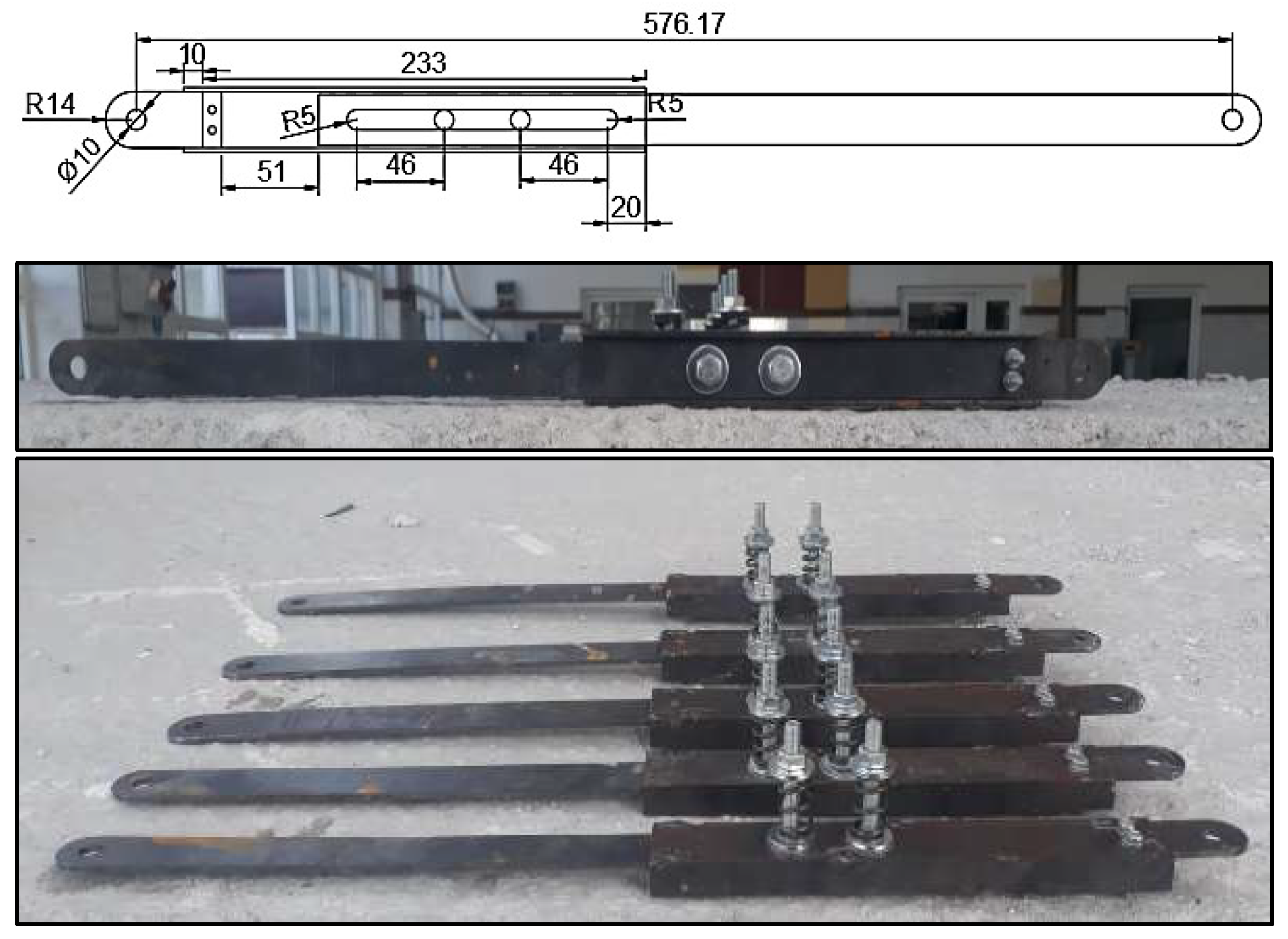
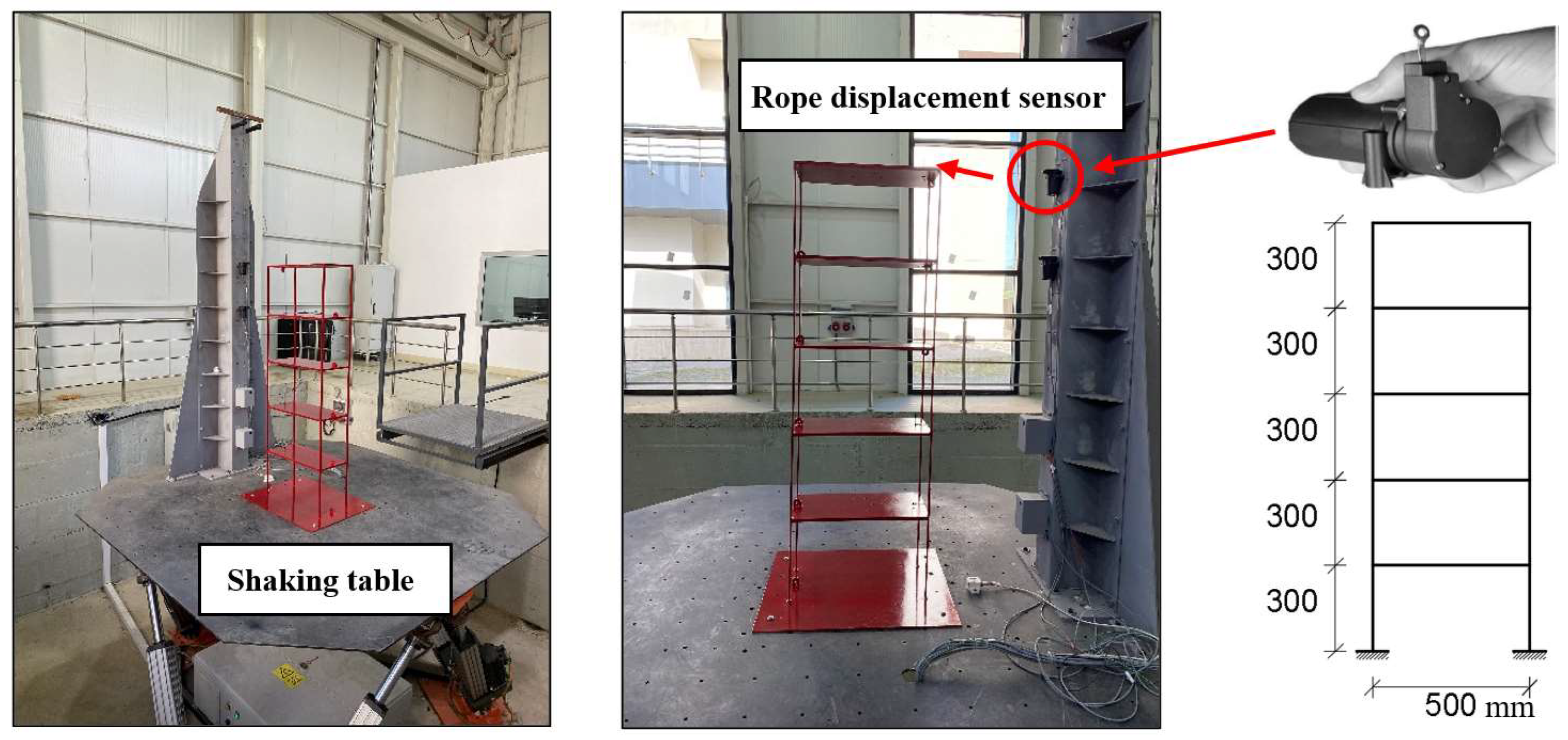
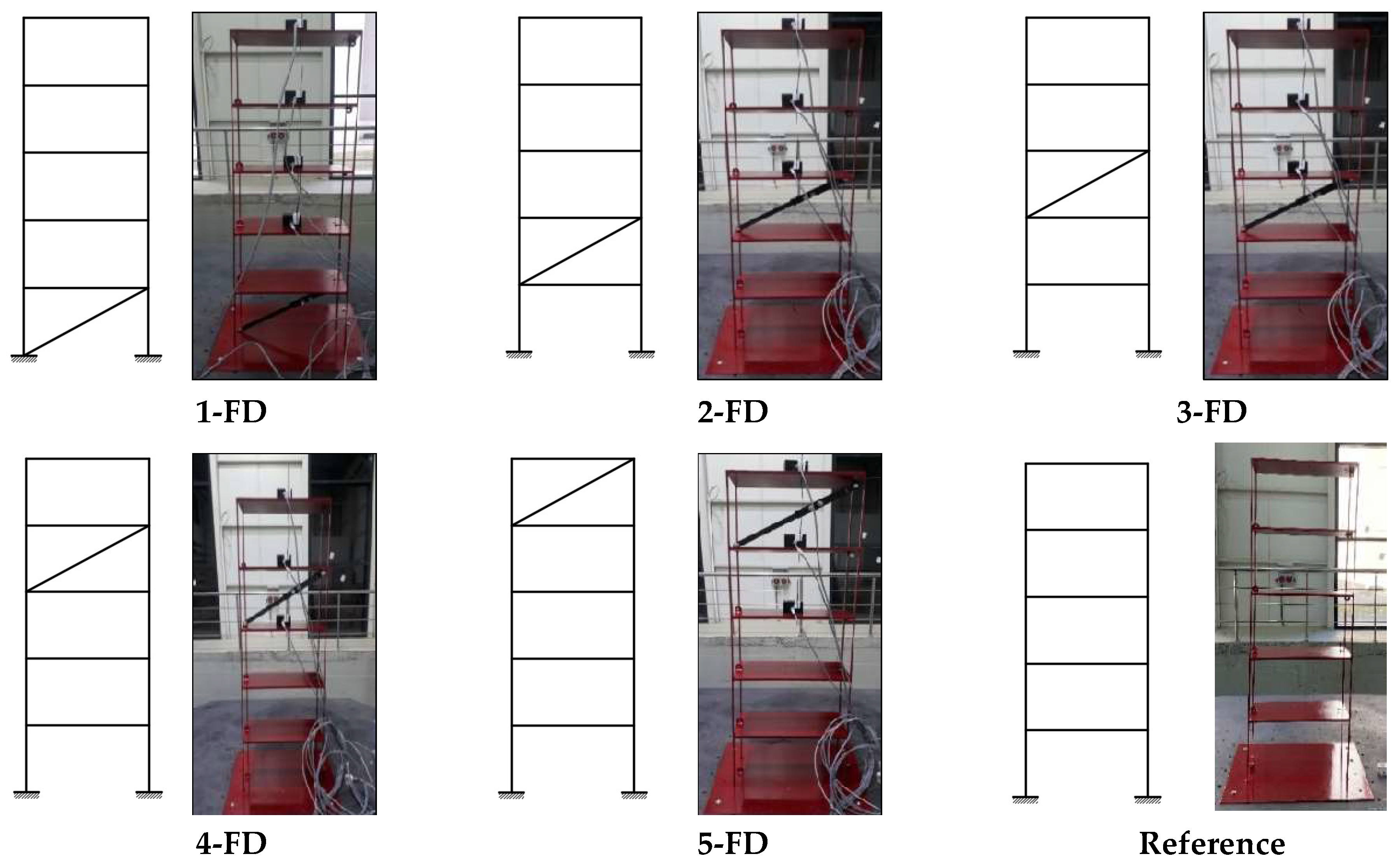
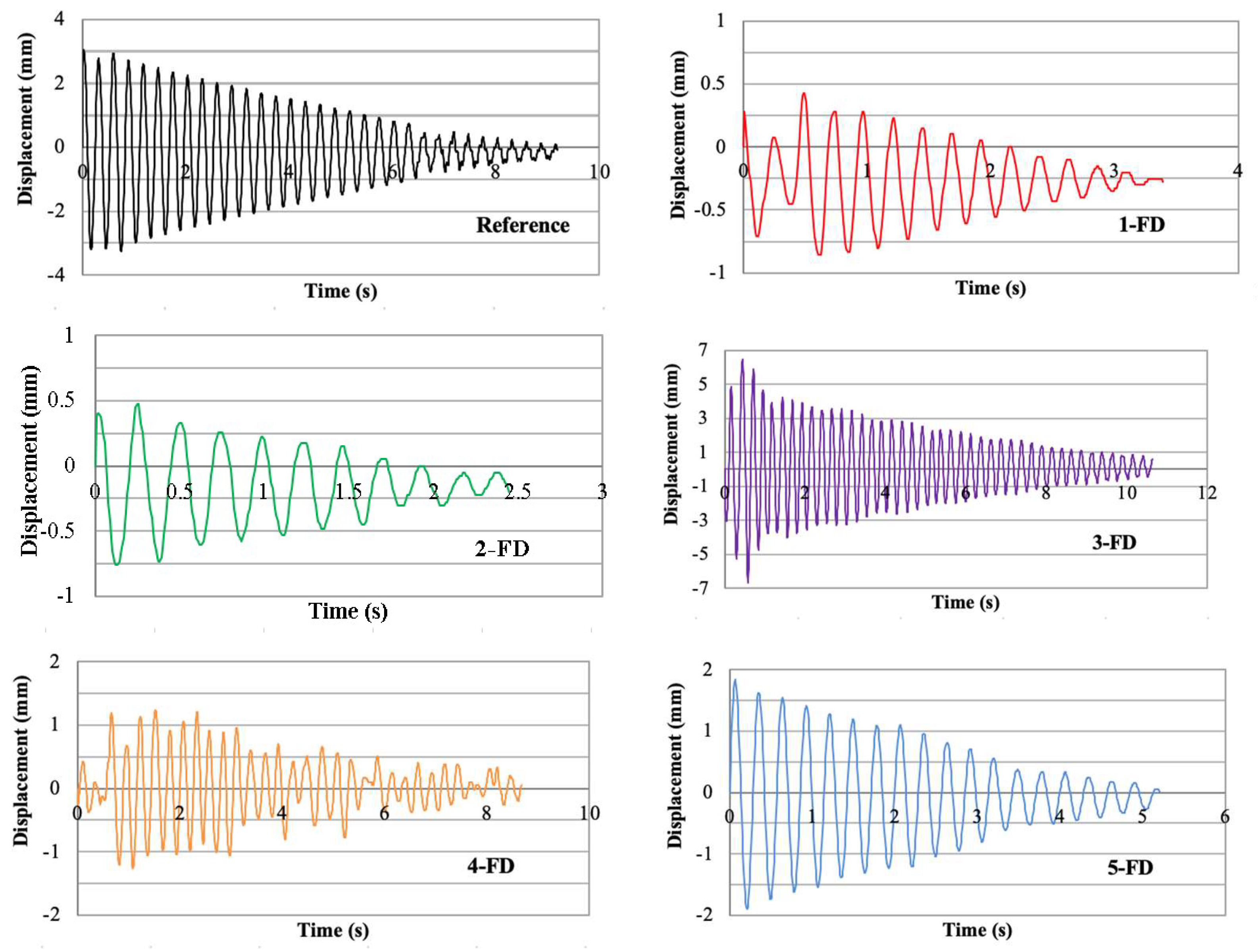


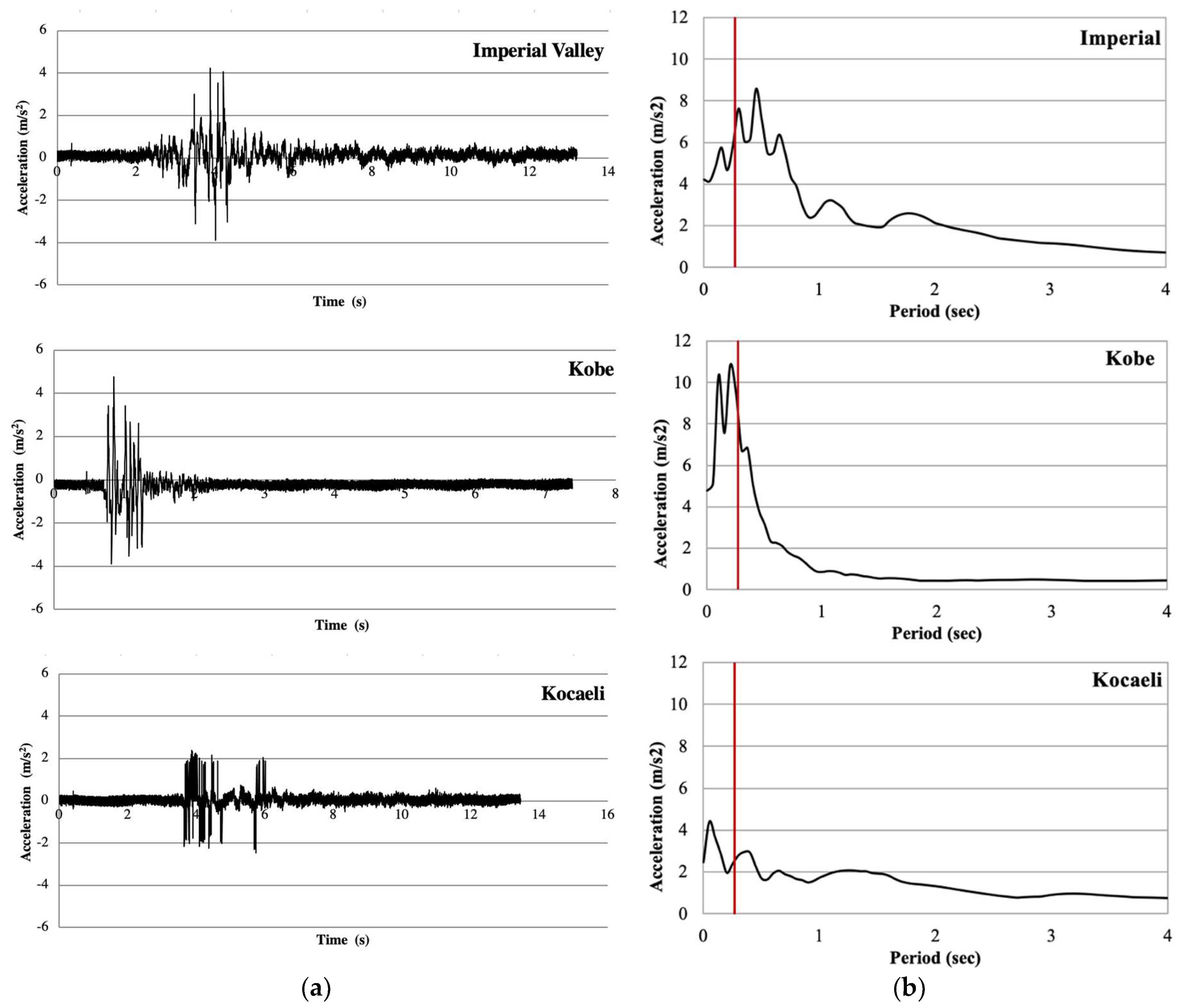

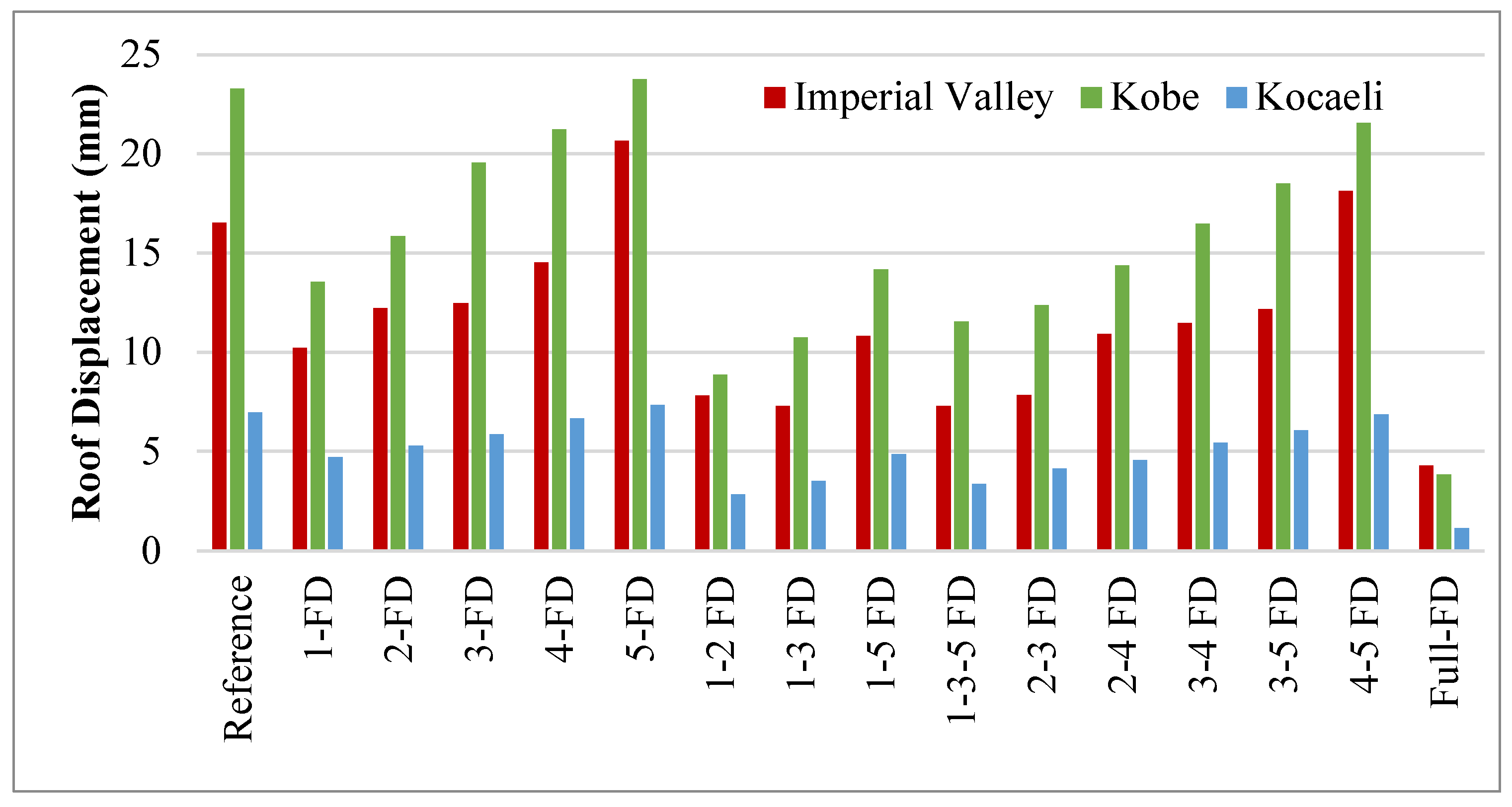

| Quantity | Acceleration Similarity |
|---|---|
| Displacement, δ | λ1/2 |
| Speed, v | λ1/2 |
| Acceleration, a | 1 |
| Mass, m | λ2 |
| Density, ρ | 1/λ |
| Weight, W | λ2 |
| Force, Q | λ2 |
| Time, t | λ1/2 |
| Frequency, f | 1/λ1/2 |
| Weight stress, σ | 1 |
| Seismic stress, σ | 1 |
| Geometric Scaling Factor | X Direction (mm) | Y Direction (mm) | Total Building Height (mm) | Weight (kg) | Frequency (Cycles/Second) | |
|---|---|---|---|---|---|---|
| n | λ = 1/n | |||||
| 1 | 1 | 4000 | 2000 | 12,000 | 33,593.92 | 1.41 |
| 2 | 0.5 | 2000 | 1000 | 6000 | 4199.24 | 1.99 |
| 4 | 0.25 | 1000 | 500 | 3000 | 524.91 | 2.82 |
| 6 | 0.167 | 666.67 | 333.33 | 2000 | 155.53 | 3.45 |
| 8 | 0.125 | 500 | 250 | 1500 | 65.61 | 3.99 |
| Damper | Rn | μ | hf | Number of Bolts | (N) | Compression Amount (mm) | ||
|---|---|---|---|---|---|---|---|---|
| 1st floor | 173.83 | 0.2 | 1 | 2 | 1 | 2 | 217.29 | 8.309 |
| 2nd floor | 165.67 | 0.2 | 1 | 2 | 1 | 2 | 207.09 | 7.919 |
| 3rd floor | 153.29 | 0.2 | 1 | 2 | 1 | 2 | 191.62 | 7.327 |
| 4th floor | 120.59 | 0.2 | 1 | 2 | 1 | 2 | 150.73 | 5.764 |
| 5th floor | 65.75 | 0.2 | 1 | 2 | 1 | 2 | 82.19 | 3.143 |
| Reference | 1-FD | 2-FD | 3-FD | 4-FD | 5-FD | |
|---|---|---|---|---|---|---|
| Period (sec) | 0.280 | 0.216 | 0.240 | 0.256 | 0.280 | 0.288 |
| Period (sec) | Reference | 1-FD | 2-FD | 3-FD | 4-FD | 5-FD |
|---|---|---|---|---|---|---|
| Experimental | 0.280 | 0.216 | 0.240 | 0.256 | 0.280 | 0.288 |
| Numerical model | 0.271 | 0.224 | 0.226 | 0.248 | 0.270 | 0.285 |
| Imperial Valley | Kobe | Kocaeli | ||||
|---|---|---|---|---|---|---|
| Configuration | Roof Displacement (mm) | Displacement Reduction Rate (%) | Roof Displacement (mm) | Displacement Reduction Rate (%) | Roof Displacement (mm) | Displacement Reduction Rate (%) |
| Reference | 16.53 | - | 23.30 | - | 7.00 | - |
| 1-FD | 10.21 | −38.23 | 13.60 | −41.63 | 4.70 | −32.86 |
| 2-FD | 12.21 | −26.13 | 15.90 | −31.76 | 5.30 | −24.29 |
| 3-FD | 12.46 | −24.62 | 19.60 | −15.88 | 5.90 | −15.71 |
| 4-FD | 14.53 | −12.10 | 21.20 | −9.01 | 6.65 | −5.00 |
| 5-FD | 20.66 | 24.98 | 23.80 | 2.15 | 7.30 | 4.29 |
| 1-2 FD | 7.80 | −52.81 | 8.80 | −62.23 | 2.80 | −60.00 |
| 1-3 FD | 7.28 | −55.96 | 10.75 | −53.86 | 3.50 | −50.00 |
| 1-5 FD | 10.81 | −34.60 | 14.20 | −39.06 | 4.90 | −30.00 |
| 1-3-5 FD | 7.29 | −55.90 | 11.50 | −50.64 | 3.35 | −52.14 |
| 2-3 FD | 7.85 | −52.51 | 12.40 | −46.78 | 4.10 | −41.43 |
| 2-4 FD | 10.93 | −33.88 | 14.40 | −38.20 | 4.55 | −35.00 |
| 3-4 FD | 11.48 | −30.55 | 16.50 | −29.18 | 5.40 | −22.86 |
| 3-5 FD | 12.18 | −26.32 | 18.50 | −20.60 | 6.05 | −13.57 |
| 4-5 FD | 18.14 | 9.74 | 21.55 | −7.51 | 6.85 | −2.14 |
| Full-FD | 4.28 | −74.11 | 3.83 | −83.56 | 1.10 | −84.29 |
| Base Shear Force (N) | ||||||||||||||||
|---|---|---|---|---|---|---|---|---|---|---|---|---|---|---|---|---|
| Reference | 1 FD | 2 FD_ | 3 D_ | 4 FD_ | 5 FD_ | 1-2 FD | 1-3 FD | 1-5 FD | 2-3 FD | 2-4 FD | 3-4 FD | 3-5 FD | 4-5 FD | 1-3-5 FD | Full FD | |
| Kocaeli | 200.5 | 35.30 | 195.8 | 214.6 | 210.7 | 216.6 | 35.4 | 37.3 | 51.0 | 200.9 | 213.5 | 229.1 | 228.6 | 224.2 | 53.3 | 60.3 |
| Imperial Valley | 428.1 | 199.3 | 415.2 | 375.9 | 419.5 | 547.4 | 146.4 | 149.1 | 202.9 | 324.9 | 408.1 | 385.9 | 381.6 | 518.6 | 167.6 | 172.4 |
| Kobe | 616.5 | 319.0 | 520.7 | 559.6 | 592.5 | 607.4 | 235.8 | 284.9 | 284.9 | 471.7 | 473.6 | 531.5 | 538.8 | 606.0 | 288.7 | 157.4 |
Disclaimer/Publisher’s Note: The statements, opinions and data contained in all publications are solely those of the individual author(s) and contributor(s) and not of MDPI and/or the editor(s). MDPI and/or the editor(s) disclaim responsibility for any injury to people or property resulting from any ideas, methods, instructions or products referred to in the content. |
© 2023 by the authors. Licensee MDPI, Basel, Switzerland. This article is an open access article distributed under the terms and conditions of the Creative Commons Attribution (CC BY) license (https://creativecommons.org/licenses/by/4.0/).
Share and Cite
Aydin, E.; Boru, E.; Gurbuz, M. Effects of Diagonal Friction Dampers on Behavior of a Building. Appl. Sci. 2023, 13, 8311. https://doi.org/10.3390/app13148311
Aydin E, Boru E, Gurbuz M. Effects of Diagonal Friction Dampers on Behavior of a Building. Applied Sciences. 2023; 13(14):8311. https://doi.org/10.3390/app13148311
Chicago/Turabian StyleAydin, Emine, Elif Boru, and Mert Gurbuz. 2023. "Effects of Diagonal Friction Dampers on Behavior of a Building" Applied Sciences 13, no. 14: 8311. https://doi.org/10.3390/app13148311
APA StyleAydin, E., Boru, E., & Gurbuz, M. (2023). Effects of Diagonal Friction Dampers on Behavior of a Building. Applied Sciences, 13(14), 8311. https://doi.org/10.3390/app13148311







